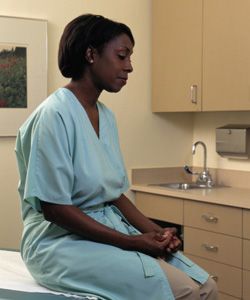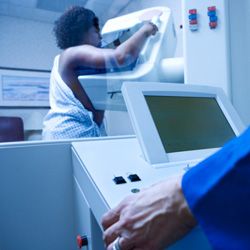
Every month on the same date, you repeat your self-exam as you recline on the bed. Your mind wanders to what is ahead for the day and week, and then, you stop. There’s something just under your finger no bigger than the size of a pea.
Panic doesn’t immediately set in as you’re still trying to make certain that something is really there. Instinctively you exam your other breast. Is the same pea-sized lump on the other one? No? Now you panic.
What to do First
Stay as calm as possible, because the odds that the lump is cancerous are low. It’s much more likely to be a simple clogged duct or other non-cancerous lump. Call your regular doctor, talk to his nurse and explain that you need an appointment immediately. You should not schedule an appointment with a cancer specialist until your doctor is able to perform some tests first.
At the Doctor’s Office
The first thing your doctor will do is repeat the same exam you did. He may tell you that it is simple fibrous tissue, or he may order further testing, such as a mammogram or ultrasound. Once he has those test results in hand, he will decide whether or not you need a biopsy.
The Results
Once the results come back, you’ll either breathe a huge sigh of relief and continue life as normal, or your doctor will want the lump biopsied. If he wants a biopsy, again, try not to panic. The majority of biopsies do not result in a diagnosis of breast cancer.
Biopsies

Depending on the size of your breasts, your doctor may be able to perform a biopsy with a simple needle insertion. If your breasts are large and dense, he may recommend a surgical biopsy instead. A surgical biopsy can also be advised if the lump is located is an area where a needle would have a more difficult time reaching.
Needle biopsies last about 30 minutes and can be performed in an outpatient setting. Surgical biopsies last a bit longer, and must be done in a hospital setting where you will receive light sedation. Both procedures withdraw a small sample of the lump and surrounding tissue. You will receive the results on a later date after the pathologist has examined the sample.
Biopsy Results
If the biopsy results are negative, again you may continue to live your life as before. Keep performing your monthly exams, as you now better understand the importance of self-exams.
If the biopsy returns a positive result, the pathology report will tell you whether the cancer is localized, the type to remain in one spot, or if the cancer has spread, or could spread, to other cells. The pathology report also stages the cancer at 0, I, II, III or IV, and will further indicate a subset number that sets out the treatment plan for your specific type of breast cancer.
The Good News
In 2010, there were 2.5 million breast cancer survivors. If you know anyone who has had breast cancer, or have seen celebrities report that they’ve had breast cancer, you may not even have known they were ill. Treatment protocols have become so advanced that many women no longer suffer through difficult symptoms including hair loss, weight loss or vomiting that used to occur with many treatments. You have done your exams regularly and more than likely caught the cancer early.
Want More?
Join the CurlTalk conversation and send positive vibes towards those who are affected.
Final Thoughts
Have you ever had to have a biopsy? Share your experiences here and connect with others who have felt your fear.
